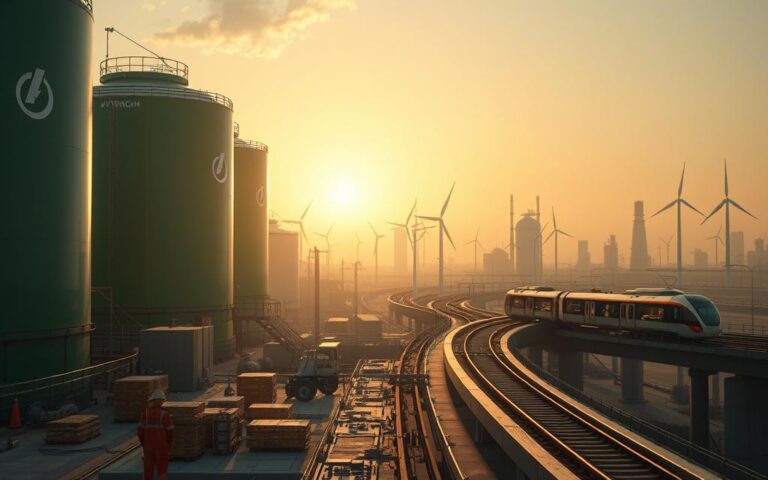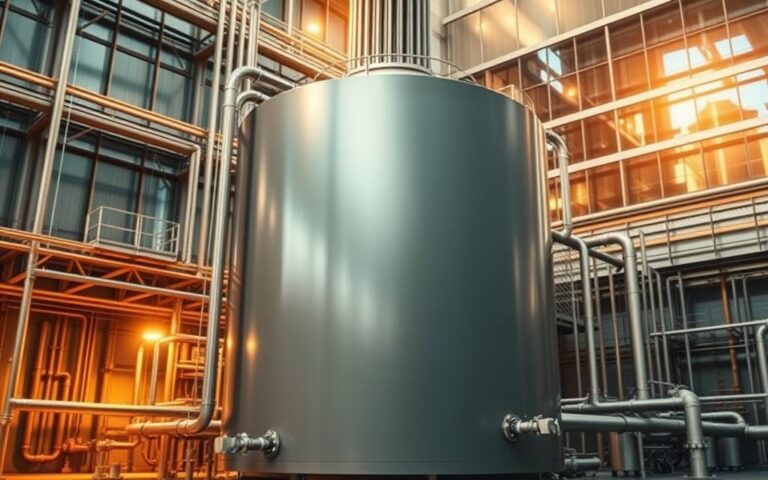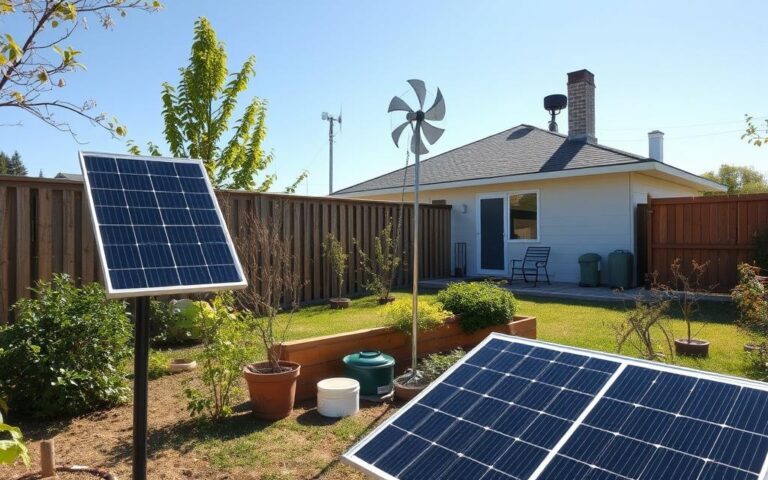
A single residential wind turbine can offset up to 1.5 tons of carbon dioxide annually. Small-scale wind power is changing how homeowners approach renewable energy. Affordable wind power is now an achievable reality for many American households.
Residential wind energy offers a new way to generate sustainable home power. Small-scale turbines help homeowners cut electricity costs and protect the environment. These compact systems are becoming more accessible, reshaping personal energy production.
Modern small-scale turbines give homeowners control over their energy use. Families can reduce their carbon footprint and save money on electricity bills. These renewable technologies offer exciting possibilities for eco-friendly living.
The market for affordable wind power systems is growing rapidly. New tech and lower installation costs make these solutions more appealing. Homeowners can now embrace clean energy right in their own backyards.
Let’s explore residential wind energy systems, their components, and economic benefits. We’ll cover installation strategies and potential savings. Discover how small-scale turbines can change your home energy production.
Understanding Small-Scale Wind Energy Systems
Residential wind turbines offer a fresh take on home energy production. These small systems provide clean, renewable power right from your property. They’re a strong alternative to traditional electricity sources.
Wind energy tech has made great strides. Small wind systems are now more accessible and efficient for homes. Homeowners can use well-designed turbines to turn wind into electrical energy.
Basic Components of Residential Wind Turbines
Every residential wind turbine consists of several critical components:
- Rotor blades that capture wind energy
- Generator for converting mechanical energy to electricity
- Tower supporting the entire system
- Control mechanisms for optimal performance
How Small Wind Systems Generate Power
Wind turbines capture energy from moving air. The wind spins rotor blades, which turn a shaft connected to a generator. This mechanical motion creates electrical current for powering homes or storing in batteries.
Grid-Connected vs. Off-Grid Solutions
Homeowners have two main options for wind energy:
- Grid-Connected Systems: Directly feed excess electricity back to the power grid
- Off-Grid Solutions: Operate independently, storing energy in batteries for continuous use
Each option has its own perks for wind turbine owners. The best choice depends on local setup and energy needs.
The Economics of Affordable Wind Power
Wind power economics have changed greatly, making renewable energy more appealing for homeowners. Small-scale wind turbines offer a cost-effective way to reduce electricity bills. These systems can lead to significant long-term savings.
Residential wind systems cost between $3,000 and $8,000 to install. The price depends on system size and installation difficulty. However, the benefits often outweigh the initial costs.
- Typical residential wind turbine generates 300-2,000 kilowatt-hours monthly
- Average electricity offset: 50-90% of household consumption
- Potential payback period: 6-10 years
Wind energy investment becomes more attractive with federal tax credits and state incentives. Homeowners can recover up to 30% of installation costs through current tax programs. This makes the transition to wind power more affordable.
| Cost Factor | Small Wind System | Traditional Grid Electricity |
|---|---|---|
| Initial Investment | $3,000 – $8,000 | $0 |
| Annual Energy Costs | $0 – $200 | $1,200 – $1,800 |
| Maintenance Expenses | $100 – $300/year | $0 |
To fully grasp wind power economics, consider local wind resources and electricity rates. System efficiency also plays a key role. Strategic placement and proper site assessment can boost the financial benefits of wind energy investments.
Choosing the Right Small Wind Turbine for Your Property
Picking the ideal wind turbine requires careful planning. Your property’s features and energy needs guide this personalized process. There’s no universal solution for wind turbine selection.
Before buying a small wind system, assess your site’s wind power potential. This evaluation looks at key factors affecting turbine performance. These factors can greatly impact efficiency.
Evaluating Your Property’s Wind Potential
Start by understanding your local wind patterns. This is crucial for wind resource evaluation.
- Average wind speed in your region
- Terrain and landscape characteristics
- Potential wind obstacles like buildings or trees
- Height and placement of the turbine
Determining Power Output Requirements
Match your turbine to your energy use. This step is vital for homeowners.
- Calculate monthly electricity usage
- Assess available installation space
- Review local zoning restrictions
- Consider budget constraints
Wind Turbine Size Considerations
Small wind turbines range from 400 watts to 100 kilowatts. Selecting the right size depends on your specific energy requirements and site conditions. Professional assessments can help choose the best turbine for you.
“The key to successful wind turbine selection is understanding your unique energy landscape.” – Renewable Energy Expert
Installation and Maintenance Costs Breakdown

Wind turbine installation costs are vital for homeowners exploring renewable energy options. A small-scale wind turbine can cost $3,000 to $8,000 per kilowatt. The price varies based on system complexity and site needs.
Wind turbine installation includes several key cost components:
- Equipment purchase
- Tower construction
- Electrical system integration
- Permitting and inspection fees
Maintenance costs are crucial for long-term planning. Residential wind turbines need yearly checks and upkeep for best performance. These ongoing expenses typically range from $100 to $500 annually.
Key maintenance tasks include:
- Annual professional inspections
- Lubrication of moving parts
- Checking electrical connections
- Replacing worn components
A wind turbine’s total lifecycle cost depends on local wind resources and system quality. Regular upkeep is also a factor. Homeowners can expect a well-maintained wind turbine to last 20-25 years.
This makes wind power a potentially cost-effective renewable energy option. Good installation and maintenance can greatly extend your system’s life and efficiency.
Investing in proper installation and consistent maintenance can significantly extend the life and efficiency of your wind energy system.
Government Incentives and Tax Credits for Wind Energy
Small-scale wind energy systems can be more affordable for homeowners through various incentives and tax credits. These financial supports make renewable energy more accessible for residential properties. They help offset installation costs significantly.
Federal and local authorities offer ways to reduce wind turbine installation expenses. Understanding these rebates helps homeowners make smart choices about clean energy investments.
Federal Tax Incentives for Wind Energy
The federal government provides significant tax credits for residential wind energy systems. These incentives can greatly reduce overall costs.
- Investment Tax Credit (ITC) covering up to 30% of wind turbine installation costs
- Production Tax Credit (PTC) for energy generated by residential wind systems
- Accelerated depreciation benefits for wind energy equipment
State-Level Wind Energy Support Programs
States offer unique wind energy incentives to promote renewable energy adoption. These programs vary widely across different states.
- Direct cash rebates for wind turbine installations
- Property tax exemptions for renewable energy systems
- Low-interest loans for wind energy projects
Local Utility Rebate Opportunities
Local utility companies often provide extra financial support for wind energy investments. Homeowners can explore several options to maximize their benefits.
- Net metering programs that credit excess energy production
- Direct cash rebates for grid-connected wind turbines
- Performance-based incentives tied to energy generation
Researching available wind energy incentives can help homeowners maximize their financial benefits and support sustainable energy solutions.
DIY Wind Power: Reducing Installation Expenses
Homeowners are turning to DIY wind turbines for cost-effective clean electricity. Self-installing wind power systems can cut expenses dramatically. It’s an exciting project for sustainable energy enthusiasts.
DIY wind turbines need careful planning and understanding of key components. Successful self-installation depends on several critical factors:
- Technical skill level
- Available tools and equipment
- Site-specific wind conditions
- Personal safety considerations
Wind turbine kits designed for self-installation offer an easy start. These kits help homeowners save money on renewable energy projects.
| DIY Component | Estimated Cost Savings | Difficulty Level |
|---|---|---|
| Tower Assembly | 20-35% | Moderate |
| Electrical Connections | 15-25% | Advanced |
| Foundation Preparation | 30-45% | Intermediate |
Homeowners should assess their technical skills before starting a DIY wind power project. Professional consultation is recommended for complex electrical and structural components to ensure safety and system reliability.
Safety should always be the primary consideration when attempting DIY wind turbine installations.
Get necessary permits and understand local zoning rules before starting. Invest in quality components that match your specific wind environment.
Overcoming Zoning and Permit Challenges
Small-scale wind energy projects face complex zoning regulations. Local rules often create barriers to wind turbine installations. Homeowners need careful planning and a strategic approach to navigate these challenges.
Wind energy projects rely on meeting local permit requirements. Property owners must tackle several key issues during approval. Understanding these challenges is crucial for success.
Understanding Local Wind Energy Regulations
Each town has unique wind turbine zoning rules. These guidelines can greatly affect installation options. Homeowners should research several important areas.
- Height restrictions for wind turbines
- Minimum property setback distances
- Noise limitation standards
- Visual impact considerations
- Structural safety requirements
Working with Community Guidelines
Engaging with local authorities and community members can boost approval chances. Strategic communication about environmental and economic benefits is key. This approach helps build support for your project.
Permit Application Process
A thorough permit application requires detailed documentation. Gathering this information is crucial for success.
- Detailed site plan
- Wind resource assessment
- Technical specifications of proposed turbine
- Environmental impact statement
- Proof of structural compliance
Installing a wind turbine demands patience and thorough research. A collaborative approach to local rules is essential. Understanding requirements and showing responsible planning helps overcome zoning hurdles.
Return on Investment and Energy Savings
Small-scale wind energy systems offer impressive financial benefits for homeowners. As technology improves and costs drop, wind energy ROI becomes more attractive. Residential wind turbines can generate substantial electricity, potentially offsetting 50-90% of annual household energy use.
Calculating energy cost savings involves analyzing several key factors. Wind turbine efficiency, local electricity rates, and average wind speeds impact financial returns. Homeowners in Texas, Oklahoma, and Kansas often see faster payback due to consistent winds.
Typical residential systems can recover initial investments within 6-10 years through reduced utility bills. Modern wind turbines have operational lifespans of 20-25 years, providing consistent renewable energy. Property values may increase by 3-5% with installed wind energy systems.
Homeowners also help reduce carbon emissions, supporting broader environmental sustainability goals. Real-world data from the National Renewable Energy Laboratory shows compelling economic advantages. Strategic investment in small-scale wind technology is a smart way to manage energy costs.
Homeowners can leverage federal tax credits and state incentives to boost their wind energy investment potential. This approach supports clean power infrastructure while providing long-term financial benefits.
FAQ
How much does a small residential wind turbine typically cost?
Residential wind turbines cost between $3,000 and $50,000. The price depends on size, power output, and installation complexity. Small-scale systems usually range from $15,000 to $30,000 before incentives.
What wind speed is required for a wind turbine to be effective?
Most home wind turbines need steady winds of 7-10 mph to make good power. The best areas have average wind speeds of 10-12 mph.
Do I need a large property to install a wind turbine?
Some compact wind systems can work on smaller lots. You typically need about one acre of open land. The area should have few obstacles and good wind resources.
How long do residential wind turbines typically last?
Quality home wind turbines usually last 20-25 years with good care. Parts like blades and generators may need replacing during this time.
Can I completely eliminate my electricity bill with a wind turbine?
A well-designed wind system can cut 50-90% of your power use. The savings depend on local wind, system size, and your energy habits.
What federal tax credits are available for wind energy systems?
The Residential Renewable Energy Tax Credit offers a 30% tax break for wind turbine setups. This can greatly lower the overall cost for homeowners.
Are wind turbines noisy?
New home wind turbines are built to be quiet. They usually make 35-45 decibels of sound from a distance. That’s about as loud as a soft chat or office background noise.
How do I determine if my location is suitable for a wind turbine?
Get a pro to check your site’s wind speed, direction, and obstacles. They’ll also look at local zoning rules. Wind maps and on-site tests help figure out your wind power potential.
Can I install a wind turbine myself?
Some DIY wind turbine kits exist, but pro installation is best. This ensures safe electrical hookups and proper tower mounting. Doing part of the work yourself can help cut costs.
What maintenance does a residential wind turbine require?
Yearly upkeep includes checking blades, electrical parts, and moving parts. The tower’s stability should also be tested. Yearly pro inspections help keep the system running well for longer.



